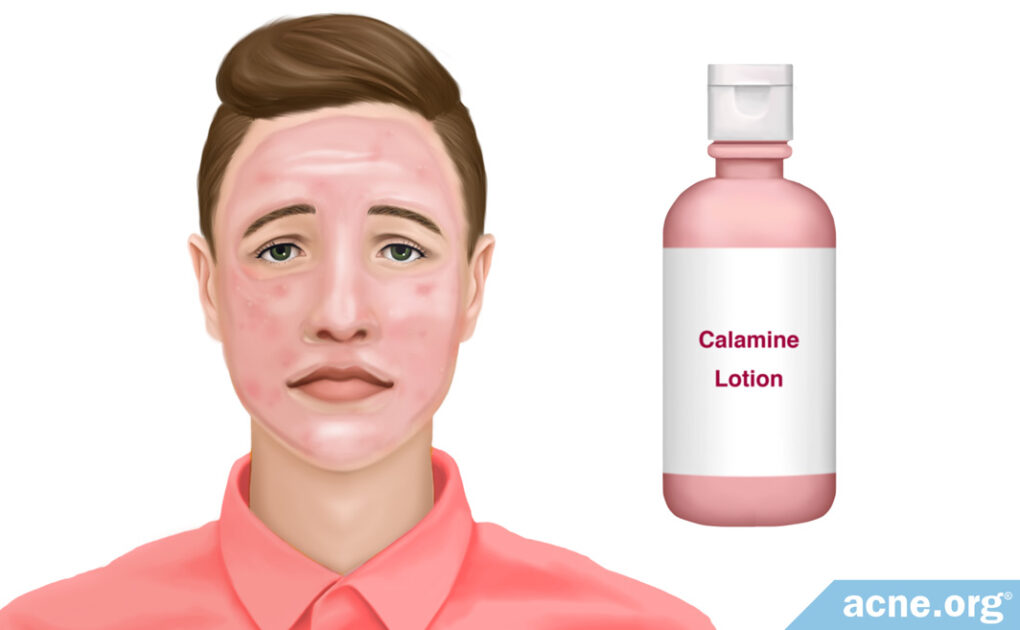The Zinc Oxide in Calamine Lotion May Help

The Essential Info
Calamine lotion is a topical skincare product best known for its ability to reduce the itchiness, redness, and swelling from skin conditions like poison ivy.
It is a simple product composed of:
- Zinc oxide: The active ingredient, which provides the lotion with its healing effects
- Ferric oxide: Simply an inert ingredient that gives calamine lotion its characteristic pink color
While scientists have not studied calamine lotion on acne directly, the zinc oxide in calamine lotion may have antibacterial, anti-inflammatory, and hormone balancing properties, which could theoretically help acne to a small degree, at least in the short term. But don’t expect noticeable results. Zinc oxide on its own has not been shown to be an impressive acne treatment.
The Bottom Line: While calamine lotion may help reduce short-term redness, it is unlikely to provide measurable relief from acne, even mild acne.

The Science
- Components of Calamine Lotion
- How Zinc Oxide Works
- The Science: Studies on Topical Zinc Oxide
- Zinc Oxide’s Effect on Acne Bacteria (C. acnes)
- What Conclusions Can We Make?
Calamine lotion is a widely used, safe, and effective skin care product that treats itchiness, redness, and swelling associated with skin inflammation caused by various skin conditions and burns. For example, one study found calamine lotion effective at reducing skin irritation caused by wearing a cast, while another study showed that calamine lotion can quickly relieve skin irritation in infants with eczema (a common condition involving dry, itchy, scaly skin).1,2
Some members of the Acne.org community have reported using calamine lotion to treat their acne.
While calamine lotion is unlikely to produce significant clearing of acne, some scientific studies that look at the active ingredient in calamine lotion, zinc oxide, point toward its potential to improve acne through (1) preventing the growth of the bacteria associated with acne called C. acnes, (2) its potential to inhibit the production of certain inflammatory molecules in the skin that may lead to some of the redness and soreness around acne lesions, and (3) its potential to help balance hormones in the skin.
Components of Calamine Lotion
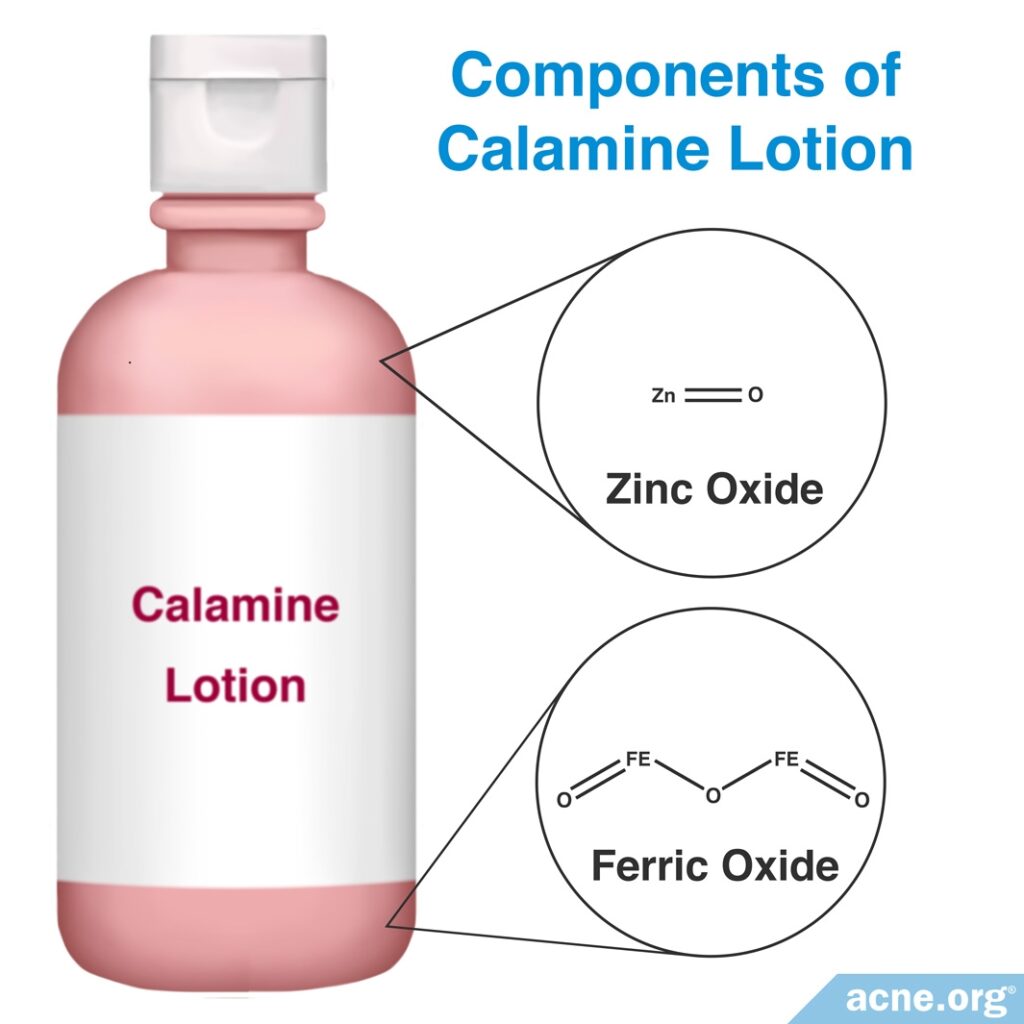
The two main components of calamine lotion are zinc oxide (15%) and ferric oxide (0.5%).3 Zinc oxide is responsible for the healing effects of calamine lotion, and ferric oxide is simply a non-toxic component that gives calamine lotion its characteristic pink color.4
How Zinc Oxide Works
There are no studies that look directly at the effects of calamine lotion on acne. However, scientists proposed three hypotheses that explain how zinc oxide may counteract skin inflammation and acne.
- Zinc oxide is an antibacterial agent that inhibits growth of the skin bacteria, C. acnes. The antibacterial effect of zinc oxide arises when it breaks down, causing zinc and oxygen derivatives to be released. These derivatives disrupt C. acnes cell structure and can lead to its death.5
- Zinc oxide reduces inflammation by stopping the release of inflammatory substances in the skin called interleukins and by preventing the recruitment of inflammatory cells to the skin.5,6
- Testosterone is present in the skin of both males and females. A protein called 5α-reductase converts testosterone into dihydrotestosterone (DHT), which is an active form of testosterone associated with acne. Zinc oxide blocks the function of 5α-reductase, preventing the conversion of testosterone into DHT.6
The Science: Studies on Topical Zinc Oxide
We have very little clinical evidence on how well topical zinc oxide works on acne. Just one study that was performed in 2000 and published in the journal Clinical and Experimental Dermatology investigated the effect of the main calamine lotion ingredient, zinc oxide, on acne. In the experiment, a lotion containing both zinc oxide and a separate antiseptic called chloroxylenol, showed good results, but the researchers believe the chloroxylenol likely provided much of the benefit.7 In other words, we currently have no evidence that zinc oxide by itself is effective for treating acne.
Expand to read details of study

Researchers compared the effectiveness of Nels cream, which contains zinc oxide and an antiseptic called chloroxylenol, to that of benzoyl peroxide. Benzoyl peroxide is a medication that is effective at treating acne. To perform this study, the researchers divided the 41 participants into 3 treatment groups. The first group received Nels cream; the second group received a 5% benzoyl peroxide cream and the third group received a placebo cream containing neither zinc oxide nor benzoyl peroxide.
Each participant was required to apply his assigned cream twice daily for eight weeks. After the eight-week period, the researchers found that the Nels cream and the benzoyl peroxide cream were equally effective at decreasing the number of acne lesions. Of all participants, 53.84% of Nels cream patients and 46.15% of benzoyl peroxide participants reported at least a 70% improvement in their acne. Only 6.66% of participants in the third group, who received neither Nels nor benzoyl peroxide cream, reported the same level of improvement. However, as the Nels cream contained an antiseptic medication in addition to zinc oxide, the scientists were unable to determine if the anti-acne effects were due to the zinc oxide, the antiseptic, or both. The researchers believe that the antiseptic likely targeted the acne-causing bacteria, C. acnes, as well as improved acne-related inflammation. It also is likely that the combination was responsible for the improvement.7
Zinc Oxide’s Effect on Acne Bacteria (C. acnes)
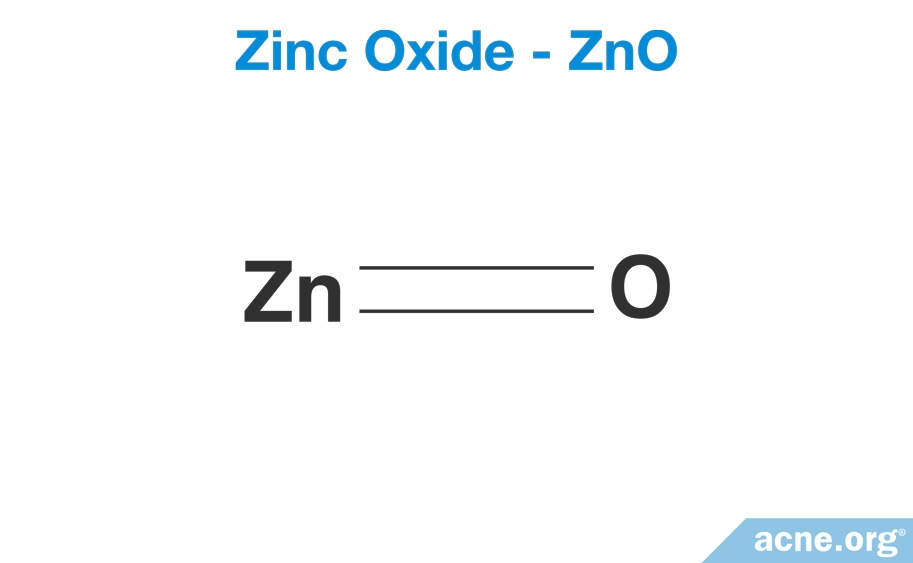
Acne is, in part, a bacterial disease, and a bacteria called C. acnes is normally found growing within clogged skin pores. C. acnes is thought to lead toward a worsening of inflammation within acne lesions.
So it makes sense that we might learn a bit more about the potential of zinc oxide from how it kills C. acnes bacteria. Studies are preliminary and have only been performed in the lab and not in human skin, so we cannot confidently extrapolate to human skin, but from what the studies show us, zinc oxide, particularly smaller particles – which calamine lotion usually does not contain – may be able to help slow the growth of C. acnes bacteria. Can the larger particles in calamine lotion work as well? More research, and preferably research on human skin, using larger particles of zinc oxide would be needed for us to answer this question more confidently.
Scientists have performed three studies thus far to investigate the antibacterial effect of zinc oxide on C. acnes. In these studies, researchers grew C. acnes bacteria in the lab and then added zinc oxide to see whether this would slow the growth of the bacteria. They found that zinc oxide was moderately successful in slowing the growth of bacteria in the lab.4,5,8 However, it remains to be seen whether a lotion containing zinc oxide would likewise slow down C. acnes growth on human skin.
Expand to read details of studies
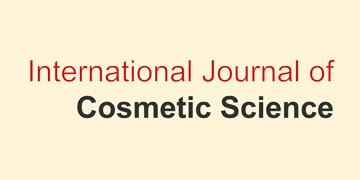
A 2016 study published in the International Journal of Cosmetic Science examined the effect of zinc oxide, citric acid, and combinations of zinc oxide and citric acid on C. acnes. To perform this study, researchers obtained C. acnes from samples stored at the Korean Cultural Center of Microorganisms. After growing the bacterial samples for two days, they then placed either zinc oxide, citric acid, or a combination of both onto the bacteria to observe how the compounds affected bacterial growth.
There are different sizes of zinc oxide molecules. The size of the molecule can be altered by adding or removing oxygen atoms. The scientists in this study tested three molecular sizes of zinc oxide – the smallest containing one oxygen atom, the medium-size molecule containing two oxygen atoms, and the largest one containing three. Researchers found that the smallest one was the most effective at preventing growth of bacteria. However, all molecule sizes were somewhat effective at preventing bacterial growth.
Citric acid had no effect on bacterial growth. However, when combined with zinc oxide, it worked better than either compound alone. The scientists concluded, “These results indicated that higher anti-microbial activity could be achieved with a combination of zinc oxide and citric acid, rather than with either substance alone.”4

A 2012 study published in the International Journal of Pharmacological and Biological Sciences examined the effect of zinc oxide nanoparticles on C. acnes growth. The researchers obtained C. acnes from human volunteers and grew it in the laboratory. They then placed the zinc oxide nanoparticles into small wells found within the dish in which the bacteria was grown. The scientists found that zinc oxide nanoparticles were effective at preventing the growth of C. acnes and could be used in various powders and creams to treat skin diseases such as acne.8

A 2014 study published in the International Journal of Cosmetic Science investigated the effect of two minerals called Yashada bhasma (YB; zinc calx) and Tankana (TA; borax), which Indian populations commonly use to treat skin ailments such as acne. Zinc calx is composed predominantly of zinc oxide, so results from this study are relevant. To perform this study, researchers grew C. acnes in the presence of either zinc calx, borax, or a combination of both, called YBTA. Then, they observed the bacteria and collected data regarding the effect of each on C. acnes growth and on inflammation. The scientists found that YBTA was the most successful at preventing acne growth, but zinc calx and borax each was able to prevent C. acnes growth as well. Additionally, zinc calx, borax, and YBTA each decreased the cellular production of an inflammatory molecule called IL-8. These two findings led the researchers to conclude, “Yashada bhasma, Tankana, or its combination may have potential for improving inflammatory acne.”5
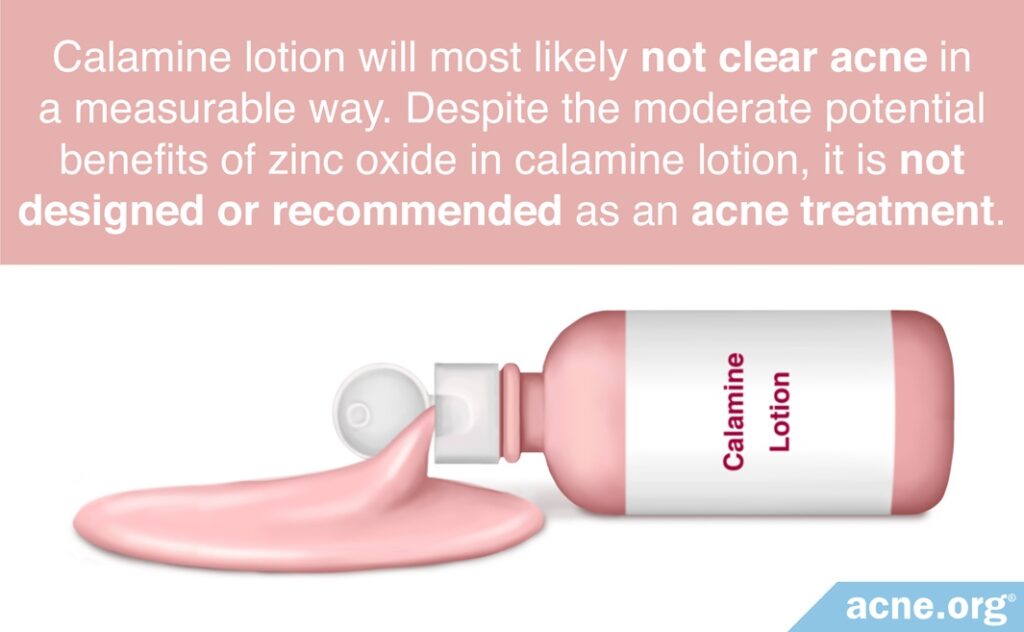
What Conclusions Can We Make?
Unfortunately, we can’t draw a firm conclusion on the antibacterial power of topically-applied zinc oxide from these studies because the studies are only done in the lab, and not on human skin. But still, they show that zinc oxide does appear to be at least somewhat antibacterial. This, combined with the successful use of calamine lotion for decades to reduce the redness and swelling of skin conditions, means it could potentially help reduce the short-term redness of acne, and, in a best case scenario, also slow the growth of acne bacteria.
However, regardless of whether it works to some degree, it most likely will not clear acne in a measurable way. If you do not suffer much from acne, it probably won’t hurt to try calamine lotion, but if you suffer from acne to a measurable degree, particularly if your acne is scarring, it is best to look into other, proven treatments.
References
- Mak, M. F., Li, W. & Mahadev, A. Calamine lotion to reduce skin irritation in children with cast immobilisation. J. Orthop. Surg. (Hong Kong). 21, 221-225 (2013). https://www.ncbi.nlm.nih.gov/pubmed/24014789
- Meng, Y. C., Fan, J. C. & Bian, W. N. Effectiveness of calamine lotion as an adjunctive therapy to mometasone furoate ointment in the treatment of infant eczema: A retrospective study. Medicine (Baltimore) 101, e30237 (2022). https://pubmed.ncbi.nlm.nih.gov/36107506/
- Hopper, L., Kaur, S. & Sharma, R. K. Effect of application of ‘calamine lotion’ on donor graft site itching among patients under Burns and plastic surgery unit. Nursing and Midwifery Research Journal 8, 1 – 8 (2012). http://medind.nic.in/nad/t12/i1/nadt12i1p21.pdf
- Wawrzyńczak, A. & Nowak, I. Synthesis and characterization of metallic oxides with potential use in cosmetic products. CHEMIK 2, 85-87 (2011). https://jnanobiotechnology.biomedcentral.com/articles/10.1186/s12951-016-0225-6
- Bae, J. Y. & Park, S. N. Evaluation of anti-microbial activities of ZnO , citric acid and a mixture of both against Propionibacterium acnes. Int. J. Cosmet. Sci. 38, 1 – 8 (2016). https://www.ncbi.nlm.nih.gov/pubmed/26940755
- Sandeep Varma, R., Shamsia, S., Thiyagarajan, O. S., Vidyashankar, S. & Patki, P. S. Yashada bhasma (Zinc calx) and Tankana (Borax) inhibit Propionibacterium acne and suppresses acne induced inflammation in vitro. Int. J. Cosmet. Sci. 36, 361 – 368 (2014). https://www.ncbi.nlm.nih.gov/pubmed/24750048
- Papageorgiou, P. P. & Chu, A. C. Chloroxylenol and zinc oxide containing cream (Nels cream®) vs. 5% benzoyl peroxide cream in the treatment of acne vulgaris. A double-blind, randomized, controlled trial. Clin. Exp. Dermatol. 25, 16 – 20 (2000). https://www.ncbi.nlm.nih.gov/pubmed/10671963
- Shailaja, M. & Roselin, P. The antibacterial activity of Zno nanoparticles against Propionibacterium acnes. Int. J. Pharma. Bio. Sci. 3, 267 – 276 (2012). https://www.researchgate.net/publication/287301749_The_antibacterial_activity_of_ZnO_nanoparticles_against_Propionibacterium_acnes
 Acne.org Products
Acne.org Products